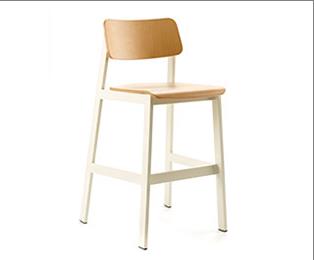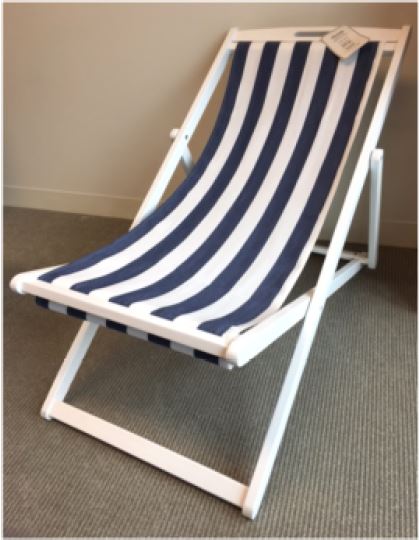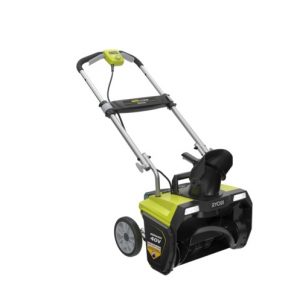Posts Tagged ‘ Recall ’
Chair Recalls Could Lead to Injuries
June 15th, 2016. By LucyC
 Couple of chair recalls caught my eye recently—collapsible chairs collapsing—unintentionally. Uh, not so good really. Especially, if you have them round the bar.
Couple of chair recalls caught my eye recently—collapsible chairs collapsing—unintentionally. Uh, not so good really. Especially, if you have them round the bar.
The first one is the Sadie Chair and Barstool, which, it seems, has dodgy legs and screws (Nope—please don’t go there…). Apparently, “The back leg of the chairs can bend and the seat tabs or screws on the seat can loosen. When loose, pinch points between the seat and steel frame are created, posing a risk of injury.”

Image: cpsc.gov
One can only imagine that with the benefit of a few too many martinis this could get a bit confusing, in addition to being injurious. There are you are, sitting next to your would-be new romance thinking, ‘Pinch me, I’m dreaming!’ over how lucky your barstool choice was when…YEOW! Pinched indeed you were! From the defective chair you’re sitting in. Great. That would certainly change the mood a bit, and perhaps the rest of the evening’s plans if it meant trading your barstool for an ER gurney.
Yes, the Grand Rapids Chair company has reportedly received three reports of finger injuries including a finger laceration, bruise and fracture.
According to the recall, about 2,300 chairs are included—specifically, Grand Rapids Chair Company Sadie chairs (model 837) and barstools (model 837S). The model number is printed on the underside of the chair, on the care and use instruction label. The chairs have a seat height of 18.5” and overall width of 22.5”, and the barstools have a seat height of 30” and overall width of 22.5”. The Sadie chairs have a steel frame of various colors with a wood seat base and seatback.
Just in case you hadn’t figured this out, “Consumers should immediately stop using these recalled chairs and barstools and contact Grand Rapids Chair Company to schedule a free repair.”

Image: cpsc.gov
The second recall is involves around 5,200 T.J. Maxx and Marshalls foldable weatherproof lounge chairs. Weatherproof but not person-proof, apparently. Fabulous. Who tests these things? Do they test these things?
Once again, you find yourself enjoying a pleasant sit down, when BAMMO! goes the barbeque and down to the floor you go. Maybe that’s why it was selling at the store for $39.99 rather than at its “Compare At” price of $70.00. But of course that’s just conjecture…
Apparently, TJX has received 15 reports of injuries from collapsing chairs. Injuries included back and tailbone injuries, one report of a fractured finger, three reports of stitches to fingers and reports of cut, bruised or swollen fingers. Really, who would have thought you get into that much trouble just from sitting down?
On this recall, consumers are being advised to” immediately stop using the recalled foldable chairs”—hello!—“and return them to any T.J. Maxx or Marshalls store for a full refund.”
Here’s the skinny—the chairs are made of an acacia wood frame and striped fabric in two styles: a natural oiled wood frame with red and white stripe fabric or a white gloss frame with blue and white stripe fabric. The chairs measure about 30 inches high by 42 inches long when unfolded. The style name, “Foldable Chair Solid Acacia Wood – Stripe Fabric – Weatherproof” is printed on the hang tag attached to the chair. The chairs sold at T.J. Maxx and Marshalls stores nationwide during March 2016 for about $40.
Time to invest in a picnic blanket I think…
Snowblower Recalls, Just in time for Summer
May 12th, 2016. By Admin
 Here’s a question—what do you do when your snow blower catches fire? Who knew they could? It’s minus 20 outside, and you’re out there clearing an apocalyptic snow fall from your driveway and bammo! —up the thing goes in flames. From snow blower to barbeque—just like that. I’m betting that would improve a person’s circulation pretty fast.
Here’s a question—what do you do when your snow blower catches fire? Who knew they could? It’s minus 20 outside, and you’re out there clearing an apocalyptic snow fall from your driveway and bammo! —up the thing goes in flames. From snow blower to barbeque—just like that. I’m betting that would improve a person’s circulation pretty fast.
Seems crazy right? But a quick scan on the US Consumer Product Safety Commission (CPSC) website reveals that spontaneous combustion (ok—that’s a little melodramatic perhaps) isn’t such an uncommon trait among these devices, begging the question—has anyone bothered to test their design?
The most recent recall for snow blowers that can overheat, “posing a fire and burn hazard,” as the CSPC puts it, is Ryobi Brushless Snow Blowers. (Yes—brushless. Don’t ask.)
On April 26th—just a little late in the season guys—a recall notice was posted for these things in the US and the great white north just across the border (Canada).
The description on the CPSC website states that One World Technologies (there’s your first clue) had posted an important safety notice on its website. They were recalling 300 of these things in the US and some 370 in Canada.
Short of experiencing the pyrotechnics first hand, how are you supposed to know if you have a defective “Ryobi 40-Volt Brushless Snow Blower”? There should be model number information on the back of the blower–and you’re looking for model numbers RY40802, RY40802A and RY40822.
The CPSC blurb continues: “One World has received two reports of snow blowers overheating during or immediately after use. Of the two reports, one consumer reported seeing flames which were immediately extinguished. No injuries or property damage have been reported.” Well, that’s a relief.
The recommended course of action to avoid possibly injury or property damage? “Consumers should immediately stop using the recalled snow blowers…(if the thing caught fire I would imagine it would have stopped working of its own accord) and return them to One World Technologies for a full refund.” Of course, if you can’t get out of your driveway because you haven’t been able to clear a path because your snow blower caught fire, well…at least summer’s on the way.
The good news is you only have to travel to you nearest Home Depot, and get in line with dozens of other people, who may be returning other defective snow blowers. Here’s a list of “related recalls” as posted on the CSPS website, just in case you missed them
All (not just some, so don’t worry if you threw the packaging out) Power America Snow Throwers
Briggs & Stratton Ariens Compact Snow Blowers, Due to Fire Hazard
Toro Power Clear Snowblowers and Recycler Mowers, Due to Fire or Burn Hazard (they’ve got both seasons covered)
American Honda Snowblowers, Due to Fire Hazard
Snow Blowers by The Toro Company, Due to Fire Hazard
Sno-Tek Snow Blowers by Liquid Combustion Technology, Due to Laceration Hazard
Love this one – “Snow Throwers by Ariens Company Due to Injury Hazard.” Yes, “Injury” – leaving their options open, I guess. According to the blurb: “Users trying to clear the collector or discharge chute while the machine is operating could be at risk of a finger or hand injury hazard.” You think?
Who knew that clearing snow could be such a dangerous and adrenalin filled experience. Wonder what grass cutting season will bring?
After Alcohol Wipe Screw-Ups, Triad Decides to Play with Makeup
October 18th, 2012. By AbiK
 Ok, could be makeup. Could be some anti-aging wonder. Could be your run-of-the-mill hand soap. Who knows? The initial reports regarding Triad Group’s foray into cosmetics have been a bit lacking in detail as to what exactly will be coming of the manufacturing lines at Triad’s Hartland, WI production plant.
Ok, could be makeup. Could be some anti-aging wonder. Could be your run-of-the-mill hand soap. Who knows? The initial reports regarding Triad Group’s foray into cosmetics have been a bit lacking in detail as to what exactly will be coming of the manufacturing lines at Triad’s Hartland, WI production plant.
Triad, if you recall, was at the heart of the alcohol prep pad, alcohol swab and alcohol swabstick, aka alcohol wipe recall of last year—the one connected to the death of 2-year old Harrison Kothari in Texas who contracted acute bacterial meningitis caused by Bacillus cereus bacteria. The Kotharis have settled with Triad—as have a dozen others who filed contamination lawsuits (details of the settlements have not been disclosed).
Fast-forward a year. The Milwaukee Journal Sentinel reported that Triad, which filed for bankruptcy protection on the heels of its $5 million insurance policy being drained on the lawsuits just mentioned, has indicated it would like to re-establish itself as a cosmetics company.
Every cat has nine lives, right?
The Journal Sentinel quoted Triad’s COO, Eric Haertle, as saying at the company’s first meeting with creditors in bankruptcy court, “We are in the infancy stage of these opportunities. We have talked to industry vendors. I am encouraged and optimistic about the support we are receiving if we can put a plan together and resume operations.”
What’s interesting here is not so much that Triad even wants to emerge like a phoenix from the ashes—hey, it’s a business wanting to cut its losses and get on with things—no, the interesting thing is their costume change; they’ll now wear the i.d. of “cosmetics company” rather than that of “medical device” company—and that has benefit for a company whose odds of reincarnation under their former classification are next to nothing.
See, in order for Triad to go back to being a medical device company and manufacturing as it had before, it faces some intense scrutiny by the FDA. According to the Journal Sentinel, both the FDA and Triad would need to agree to the FDA’s consent decree which would impose a $15,000 per day fine—per violation—should Triad fail to comply with FDA policies. Additionally, the decree would subject Triad to FDA inspections without prior notice–and those inspections could cover everything from equipment to raw materials to finished products to packaging. The decree also calls for the company to post a $4 million bond.
No small undertaking to set up shop again.
But, there’s an escape hatch: re-establishing itself as a cosmetics company means less rigorous regulation and oversight by the FDA. And given that the consent decree to operate as a medical device company again could cost Triad millions—with no guarantee they’ll even pass with flying colors—well, the land of lipstick bullets, lotions and potions suddenly has tremendous appeal.
On second thought, maybe there is a clue as to what cosmetics will be coming off Triad’s production line—those Triad alcohol swabsticks look a lot like those cotton swabs used to smudge eyeliner (for that smoky eye look) or to clean up little makeup mistakes…hmm…just wondering…
Maybe Chevy HHR should stand for How ’bout Having a Recall
October 6th, 2010. By AbiK
 These are the kind of things that piss me off. A fellow LAS staffer just happens to have a Chevy HHR. The HHR apparently stands for “Heritage High Roof”. At least that’s what Wikipedia says (you can tell I didn’t research that one too deeply). But I’m thinking HHR ought to stand for “HOW ’bout HAVING a RECALL?”.
These are the kind of things that piss me off. A fellow LAS staffer just happens to have a Chevy HHR. The HHR apparently stands for “Heritage High Roof”. At least that’s what Wikipedia says (you can tell I didn’t research that one too deeply). But I’m thinking HHR ought to stand for “HOW ’bout HAVING a RECALL?”.
Yes, a recall. For a design defect. For the ignition switch. It seems the HHR ignition switch has a tendency to get a bit, well, stuck. And that’s precisely what happened when my colleague drove into her driveway last Saturday evening. The key in her HHR got stuck. In the ignition. With the car running. Repeat: running.
Now, I’m sure many of us have experienced that damn-the-key’s-stuck thing—or the opposite, when you go to start the ignition and the key won’t turn at all. Usually a quick tug on the steering wheel will unlock the mechanism that allows your key to function properly. But what if that doesn’t work? And the car is running? Repeat: running.
What do you do? Aside, that is, from flashing back to Jackson Browne’s Running on Empty and realizing your car’s heading there—only it won’t be running on, running behind, or into the sun. It’ll be dead.
Here’s what our staffer did: She called AAA. Hell, she has a membership and they’re Read the rest of this entry »
Recall Notice: Dirty Words for Medical Devices
October 1st, 2010. By Hunter West
 There are people walking around with faulty hip implants. If they can even walk at all. This month DePuy Orthopaedics, a division of the giant Johnson & Johnson family of companies, finally recalled troublesome hip implants after removing them from the market last year. DePuy undertook the latter response amidst a hail of criticism that the metal-on-metal implant featured a flawed design.
There are people walking around with faulty hip implants. If they can even walk at all. This month DePuy Orthopaedics, a division of the giant Johnson & Johnson family of companies, finally recalled troublesome hip implants after removing them from the market last year. DePuy undertook the latter response amidst a hail of criticism that the metal-on-metal implant featured a flawed design.
Okay, so recalls are nothing new. Cars and appliances are recalled all the time. But hip implants, and heart defibrillators are not cars and appliances. They are devices implanted in a patient’s body and not easily resolved.
Who could forget the pacemaker lead from a few years ago that was recalled? The device, which made fans of surgeons who liked the ease and flexibility of the new, thinner leads that proved easier to thread to the heart, was initially hailed as a breakthrough.
And then they started to break. Fracture, really. Hairline fractures. But just enough to affect the performance of the device. Patients who required life-giving shocks to keep their hearts going weren’t getting them; while others were injured or killed when a properly performing heart was suddenly hit with a rogue electric shock because the fractured lead impeded the flow of information from the heart to the pacemaker. Believing the heart to be failing (it wasn’t), the device went into action to re-engage a heart that in reality had not failed—often with tragic consequences.
Which begs the question—why does this keep happening?
Johnson & Johnson has been under siege of late, with a spate of recalls from the DePuy hip, to artificial knee joints, to medication such as Motrin. The company has had to shut down one of its manufacturing facilities due to a departure from GMP (good manufacturing practices), and there have been questions raised about the behemoth company’s oversight. The management and conduct of J&J has been the subject of congressional investigation.
But a larger question remains, and it is one not tied to any one company—but any company Read the rest of this entry »
Archive by Category
- Accidents (24)
- Airlines (9)
- Asbestos Mesothelioma (262)
- Automotive (25)
- Celebrity (14)
- Class Action (84)
- Complaints/Comments (15)
- Consumer Fraud (84)
- Contest (2)
- Court of Public Opinion (5)
- Crazy Sh*t Lawyers See (61)
- Criminal Law (4)
- Defective Products (111)
- DePuy ASR Hip Recall (2)
- Discrimination (22)
- Drugs/Medical (248)
- Elder Care Abuse (4)
- Emerging Issues (462)
- Employment (54)
- Environment (52)
- Financial (28)
- Food Illness (15)
- Human/Civil Rights (4)
- Insecurities (5)
- Insurance (16)
- Intellectual Property (16)
- Internet/E-commerce (19)
- lawsuits (161)
- Lawyers (20)
- Lawyers Giving Back (43)
- Lex Levity (10)
- Personal Injury (106)
- Pleading Ignorance (53)
- Real Estate (2)
- Recall (6)
- Scam (3)
- Securities (13)
- Settlement (81)
- Tort Reform (2)
- Totally Tortelicious (81)
- Veterans (11)
- Whistleblower (9)